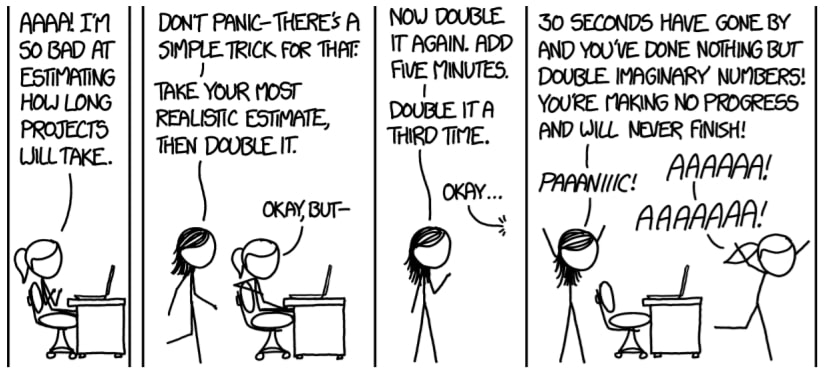Youtuber. Process management guru. ClickUp genius. Probably also a wizard or a ninja. Or both. Suffice it to say, we were thrilled to have Layla Pomper of ProcessDriven join us for one of our webinars. We use ClickUp ourselves and have found her consultation services invaluable.
The conversation was so packed with useful information, we decided to summarise the key points in this article. However, should you wish to watch the video, it's right here:

Project management challenges for marketers
Budgeting and scoping
 Hat tip to whoever made this...
Hat tip to whoever made this...
Clients have big ambitions. But, they're not always clear about what they want. Often the budgets don't quite live up to the ambition.
Or, they come to you with a brief on an 'urgent' deadline. Yes, sometimes, you need to pull the rabbit out of the hat for a client. We try not to set the expectation of that way of working, because it's not a strategic process and it's stressful for everyone involved. Better to scope and plan appropriately, then schedule out a timeline.
Dependencies
 Hat tip to whoever made this...
Hat tip to whoever made this...
This usually takes the form of approvals for work. We need clients to sign stuff off. And, pre-emptively, we need them to allow us to conduct subject matter expert interviews and explain their plans and priorities. Is a request a call to scope out a new project, or just a thought experiment? This kind of thing takes careful attention.
Balancing process, dependencies and creativity
There are also internal dependencies for project management. This is where someone is doing the research, someone is consulting with the client, someone is doing a bit of SEO keyword research, someone is doing the writing, someone is doing the design work, and so on. The more complex the piece of work, the more people involved and the more admin we have to account for, as well.
We've brought in a lot of checklists, scheduling and resource management. But, there's also a tendency for us creative souls to feel a little bit boxed in by that. So, we try to manage the processes in a flexible way to make sure everyone has room to be creative and collaborative.
Responding flexibly to changes
We talk about 'pop-up tasks' at Articulate. Some of the time these are caused by us screwing something up, admittedly. Then we have to work double-time to fix the issue (and learn not to do that again).
More often, clients change their mind. Which is perfectly acceptable. But we also reserve the right to grumble a bit, because we do have to change our process, which is inevitably more time-consuming than whatever the original plan was.
The planning fallacy a.k.a. estimating schedules
 Thank you, XKCD.
Thank you, XKCD.
If you had a week free of meetings, you could conquer the world.
Or... maybe not. If you think a task might take you a day with no interruptions and no distractions and no problems and no hiccups, then you're planning to fail. Those issues always come up. We often underestimate how long things take us to deal with. Then, we end up wondering where the time goes.
Tips from project management expert, Layla Pomper
So, those were our challenges that we experience as marketers. In short: we want to use processes to provide more creative time, not to take away from that time.
Now, let's run through these five easy steps from Layla about how to resolve these issues - and a few more besides!
But first, let's talk about ClickUp
ClickUp is project management software for organising tasks, to-dos and so on. When you are looking to switch your project management or task management software, most likely there's a reason. If you want to try out ClickUp, the first step is figuring out that reason, and why your current setup just isn't working for you. For us, we needed to build processes and see the data - the known unknowns and the unknown unknowns.
Bear in mind the software is just the tool. You need to build your own processes to make that tool work for you.
OK, now onto those tips:
1. Think of your business as a client, too
Agencies often give all their care and attention to providing services for clients, but they are like chefs eating leftovers when it comes to their own business. Treat your own business processes respectfully, as you would a client's.
2. Address stressors as metrics
Stressors are when your values are impinged on. If avoiding chaos and pressure is a value to you, then put that - preventatively - in front of everyone's mind. One way to do that is to make yourself an agenda for meetings that touches on these stress points. Or, if you use ClickUp, make a dashboard.
For example, if it's very important to never have pop-up tasks, make sure every single week you're reviewing how many pop-up tasks have come up. This way, you take something that's holding you back and you're pulling it to the front and centre of everyone's attention so you can nip it in the bud.
3. Have an issue list
This is a place where you keep a finite list of problems that have come up. As an example, Articulate has a process of 'roundtables' where we go through red flags and amber flags. When a client issue causes problems and threatens the relationship, somebody flags it. Then, we have a process of investigation and discovery - not assigning blame. In the last quarter, about a dozen issues have come up that required that level of attention. That's not an indication of how poor our service is. It's an indication of how keen we are to learn and improve.
By analysing trends over a quarter, you get data. What came up more than once? What caused the biggest challenge? What instigated the issues? Then, you can pre-empt problems by identifying parts of your process that could be improved, such as communicating certain information in advance of delivering work, so expectations are set.

4. Make process a team effort
If you're in a management role, this is the easiest one for you to implement. It starts with a sentence like this: 'Can you please add this to the Standard Operating Procedure (SOP)?'
What this does is it immediately puts SOPs - project management - right into everyone's mind. So in addition to answering a question, you take the next step of building that answer into a process, so it's available for the next time. It also puts the person who's asking the question in the driver's seat and let's them write the instructions.
5. Review your processes
Think about project management as a series of processes. You're simply making sure that the machine is humming. Reviewing your processes is just machine maintenance.
You could have this kind of conversation in your performance reviews, in your one-to-ones, or as a wider group. There, you'll want to take an inventory of how people are spending their time. That way, you can identify scope creep or why deadlines are being missed, or even if someone is doing a job that isn't their job, just because no-one is accountable for that part of the process. Sometimes there's a whole job hidden in those in-between bits.
Your processes are not set in stone. If you ask the people how long things actually take, or what steps there are in a process, or what details you might not be seeing, you'll likely find room for improvement.
Bonus tip: Organise projects around results, not job titles or arbitrary departments
If you really want to shake things up, rather than organising your whole business around skills - writing, design and so on - organise everything around projects, deliverables, client types, service offerings, or around a squad mentality, where you all interact on a consistent basis. Don't create silos just because the big corporations do it. This is a must in businesses of less than 50 people.
Project management: something between improv and flying a plane
This is how Layla thinks of project management: it's like improv jazz. You get a key and you have to be creative within that key. The limits allow the creativity to flourish. The idea is not to write the whole song and play it note-for-note. It's to provide a key.
My take is a little different, but harmonious nevertheless. At Articulate, we want to give creatives the freedom from decision fatigue and admin hell. I learned to fly planes, so in some ways, I think like a pilot. For pilots, checklists reduce the cognitive workload. They are the essential steps, but having the checklist doesn't automatically mean you know how to fly. It just means the fundamentals are right, every time. We like that. So, that's how we work.






 Hat tip to whoever made this...
Hat tip to whoever made this... Hat tip to whoever made this...
Hat tip to whoever made this... Thank you,
Thank you, 